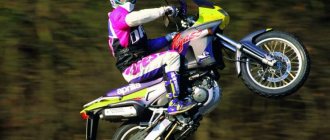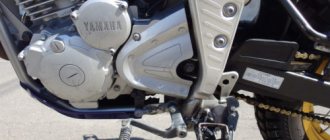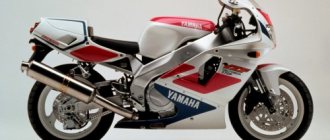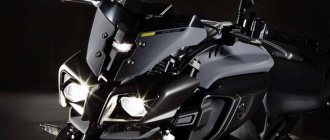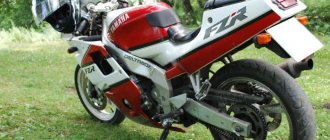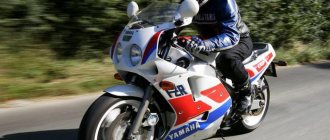It’s time to admit: in the course of evolution, such a largely canonical segment of motor vehicles as the “six hundred” naked bikes has dropped out of the overall picture. He's simply gone! Have you noticed? Many representatives, through marketing research, stepped out of the cubic capacity, and some even left the assembly line. Once upon a time, the optimally charged and equipped FZ6 Fazer model was considered the “golden ratio” of road-going mid-sized Yamaha motorcycles. In the current model range, the Yamaha MT-09 can be considered a conditionally adequate replacement for the Phaser. Using these two technically different motorcycles as an example, we will look at how technology and basic design principles change over the years within the same class.
Yamaha FZ6 (2004–2009, RUR 130,000–310,000)
Yamaha FZ6 is one of the market bestsellers of its time. It was produced in two versions: the stripped FZ6N and the semi-faired FZ6S. Technically, the motorcycle does not stand out as anything special; its value lies in its balance and adaptability for motorcyclists whose experience is just beginning to count. Having completely switched to the secondary market, the model significantly lost its popularity due to the lack of clearly defined competitive advantages.
Engine
It is well known that the engine was given to the Phaser from the Yamaha YZF-R6 combat sports bike. The in-line 16-valve injection four with a displacement of almost 600 cm3 was slightly redesigned and derated to a quite decent peak 97 liters. With. at 12000 rpm. Difficulties with increased appetite for butter in the past. The owner will not have to regularly bow to the engine to check the oil level. This power unit does not have any obvious problems with reliability.
Transmission
The Yamaha FZ6's gearbox is definitely not the standard for shift accuracy. There are some inaccuracies in gear selection. However, in terms of resources, there are no special questions. Here you should rather be afraid of instances from careless users. You could run into a burnt clutch or a classic problem with second gear.
Frame and body kit
The aluminum frame is manufactured according to the principle of minimum sufficiency. It was made into a team of two halves with a large number of voids. Such a part will be lighter than its steel counterpart and cheaper than a solid aluminum casting, but its strength and resistance to falls leave much to be desired.
The body kit consists of metal and plastic elements, which, when the exhaust is tucked into the tail (strongly warms the passenger’s “fifth point”), take the entire blow. In falls, the fuel tank is almost guaranteed to suffer. Installation of arcs or sliders is required!
Brakes
At the time the model appeared, engineers decided to save on brakes. Logically, the FZ6 family should have inherited from previous generations of Phasers very viable monoblock front four-piston calipers. But what we got was completely stupid two-piston floating “trinkets.” And a heap of one-piston calipers on the rear wheel (previously a two-piston one was installed). Already in 2007, at the time of the change of generations, Japanese technicians found the opportunity to return the “correct” brake mechanisms (four-piston monoblocks at the front) and added an anti-lock braking system to them. From that moment on, it became comfortable and safe to ride a motorcycle in a relatively violent manner.
Pendants
The chassis is tailored according to the classic canons for road vehicles of its time. The telescopic fork, in comparison with its predecessor FZS600, has grown to 43 mm in the diameter of the stays. There were no adjustments and did not appear. The fork is moderately soft. No modernization will be required for relaxed piloting. The monoshock absorber in the rear suspension is mounted almost vertically and without any progressive systems. A rather long rear swingarm ensured the appearance of a 180-gauge rear cylinder, which is not bad at all for a mid-size 600.
Comfort
Yamaha FZ6N and Yamaha FZ6S perform equally well in city use. Motorcycles don’t torture the driver with excessively radical ergonomics. The pilot's driving position is the same on the clothed and naked versions. The semi-fairing of the FZ6S makes driving on country roads more comfortable, but slightly obscures visibility. Both motorcycles can be considered in the context of motorcycle tourism, but you should take care of securing your luggage in advance and do not count on record daily mileage.
Modifications
In 2004, the Yamaha FZ6N and Yamaha FZ6S replaced the Yamaha FZS 600. In 2006, the family received a number of updates. To improve low-end traction, the fuel injection system was modified. Additionally, changes concern the design of the frame and pendulum. In addition, the frame, swingarm and rims are now painted only in black. A division appears into full-power versions of S2 and those trimmed by a limiter to 77.5 hp. With. versions S and S1. All S2s have an immobilizer as standard. In 2007, the braking system was improved (four-piston calipers and ABS), the seat was reprofiled, a cosmetic upgrade was made, the optics were modernized, and a dashboard unified with the FZ1 appeared. Since 2010, Yamaha has stopped producing “Phasers” with an engine capacity of 600 cm3; in this segment, the company briefly had only “Diversion”.
Dimensions and weight
Depending on the version, weight may vary slightly. However, the range of change is small and the average curb weight of this model is about 200 kg. However, this is largely due to the spacious tank of 19 liters. Many will consider this to be too high an indicator for such a simple city bike, because it is not at all suitable for spacious country roads. The average saddle height is 795 mm.
Yamaha MT-09 (2012 – present, RUB 330,000–720,000)
The appearance of the MT-09 family marked the arrival of a new stage in Yamaha's development. Design-wise, the first versions did not stand out much, but the same cannot be said about the technical side. The arrival of a three-cylinder engine design is a bold and strong move. Thanks to its actual and technical novelty, the Yamaha MT-09 occupies a leading position both in the segment of new motorcycles and in the secondary market.
Engine
The inline 12-valve three-cylinder fuel-injected power plant has never been considered the domain of Japanese brands. However, the risk justified the means. The engine turned out to be extremely interesting and lively (115 hp at 10,000 rpm). It works and sounds right. For lovers of Japanese motorcycles, fed up with in-line fours, this is a more than interesting experience.
Japanese engineers, despite all the strength of their kung fu, could not or did not want to completely remove the vibrations characteristic of the “three-barreled gun”. For each operating mode, the engine has its own set of small and large tremors, which are transmitted to the driver and passenger. In the city, such behavior can make driving emotional, but outside the city, on the contrary, it can be tormenting. Even without vibrations, the engine is quite noisy. There are known warranty issues with the timing chain tensioner. Already after 1500–2000 km it may stop producing the required force, which leads to the characteristic rumbling of the timing chain.
Due to the design features, the in-line “three” pulls persistently and assertively throughout almost the entire operating speed range. In order to bring the maximum amount of control into the hands of the driver, who may not be ready for the MT-09's temper, Yamaha engineers in 2016 retrofitted the motorcycle with a two-stage TCS (traction control system) system in addition to the standard D-mode system, which is responsible for changing injection maps .
A number of owners note that the electronic throttle control system is somewhat unfriendly. The electronics are configured in such a way that it is almost impossible to move off smoothly at first. It takes a long time to adapt, unnecessarily loading the drive chain and clutch in the process.
In the literal sense, the weak point of the engine should be considered to be the plug located seriously below the exhaust manifold, through which the oil is drained. Jumping from the curb is contraindicated! The slightest touch of the belly on something hard is almost guaranteed to immobilize the motorcycle.
Transmission
The six-speed gearbox of the Yamaha MT-09 is devoid of “childhood diseases”. The gears switch smoothly and predictably. In the case of a particularly greyhound driving style, the drive chain turns into a low-resource consumable. So that owners who have tasted the power of the 900 cc “three” can squeeze the maximum possible out of the engine, in 2021 a slipper clutch and a one-way quick shifter have appeared in the equipment list.
Frame and body kit
The aluminum frame is very minimalistic. Almost her entire body is hidden very deep in the bowels of the motorcycle. Damage is only possible in frontal impacts. In other cases, when in contact with asphalt, a few linings, engine covers, steering wheels and controls suffer.
During the recall campaign, dealers massively changed the steering columns along with the bolts securing them (they could have turned out to be hollow by mistake). Some motorcycles were also recalled due to problems with the anti-lock braking system and the length of the wiring harness for the head optics.
Brakes
Four-piston monoblock calipers on the front wheel of the Yamaha MT-09 are a strong argument for dominance both on the road and on the track. The brake system is almost entirely taken from a sports motorcycle. For a naked bike there is plenty of potential in places. Unfortunately, the Japanese never made it a rule to install reinforced brake hoses as a rule. They won’t hurt on a lively and fast naked bike.
Pendants
In this case, an inverted telescopic fork with a pipe diameter of 41 mm not only plays on the external perception, but together with a progressively mounted monoshock absorber also gives the motorcycle sharp, almost sporty handling. At standard settings (the rear and front are adjusted by preload and rebound), the suspension is far from racing standards, which does not prevent the motorcycle from flowing in a controlled manner and meeting sports standards on the track. On pre-restyling versions of the MT-09, during the acceleration process, an excessive tendency of the motorcycle to squat to the rear was noticed, causing the front part to unload ahead of time, worsening control and handling. From 2021, the MT-09/Tracer features stiffer shock absorbers to prevent early unloading of the front end of the motorcycle during acceleration.
Comfort
Yamaha MT-09 is a one hundred percent inhabitant of the asphalt jungle and tracks. It is difficult to imagine this motorcycle outside of good asphalt. The combination of a dense layout of the driver's workplace and a not very large fuel tank (only 14 liters) reduces the touring potential of the model to almost nothing. The same applies to luggage transportation. The minimalistic tail does not fit well with luggage systems. Installing even a central trunk significantly expands the overall dimensions.
Modifications
Serial production of the Yamaha MT-09 and Yamaha MT-09A (version with ABS) began in 2014. In 2015, the Tracer modification appeared. Since 2016, the motorcycle has been produced only in a version with ABS, and traction control has appeared. In 2021, a global restyling is taking place. The MT-09 gets an updated look. In particular, two-segment head optics with a sly squint of narrow headlights, a redesigned tail section with a new flashlight and a license plate attached to the pendulum. Additionally, engineers adjust the exhaust system to new environmental standards, replace the shock absorber with a stiffer one, and install a slipper clutch and quickshifter. In 2021, a special version MT-09 SP was presented at EICMA, differing from the basic one in decorative elements and more efficient Ohlins suspensions.
